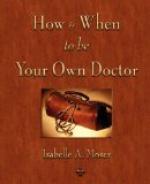How long should a person fast? In cases where there are serious complaints to remedy but where there are no life threatening disease conditions, a good rule of thumb is to fast on water for one complete day (24 hours) for each year that the person has lived. If you are 30 years old, it will take 30 consecutive days of fasting to restore complete health. However, thirty fasting days, done a few days here and a few there won’t equal a month of steady fasting; the body accomplishes enormously more in 7 or l4 days of consecutive fasting, than 7 or 14 days of fasting accumulated sporadically, such as one day a week. This is not to say that regular short fasts are not useful medicine. Periodic day-long fasts have been incorporated into many religious traditions, and for good reason; it gives the body one day a week to rest, to be free of digestive obligations, and to catch up on garbage disposal. I heartily recommend it. But it takes many years of unfailingly regular brief fasting to equal the benefits of one, intensive experience.
Fasting on water much longer than fifteen consecutive days may be dangerous for the very sick, (unless under experienced supervision) or too intense for those who are not motivated by severe illness to withstand the discomfort and boredom. However, it is possible to finish a healing process initiated by one long water fast by repeating the fast later. My husband’s healing is a good example of this. His health began to noticeably decline about age 38 and he started fasting. He fasted on water 14 to 18 days at a time, once a year, for five consecutive years before most of his complaints and problems entirely vanished.
The longest fast I ever supervised was a 90 day water fast on an extraordinarily obese woman, who at 5’ 2” weighed close to 400 pounds. She was a Mormon; generally members of the LDS Church eat a healthier diet than most Americans, but her’s included far too much of what I call “healthfood junkfood,” in the form of whole grain cakes and cookies, lots of granola made with lots of honey, oil, and dried fruit, lots of honey heaped atop heavily buttered whole grain bread. (I will explain more about the trap of healthfood junkfood later on.) A whole foods relatively meatless diet is far superior to its refined white flour, white sugar and white grease (lard) counterpart, but it still produced a serious heath problem in just 30 years of life. Like many women, she expressed love-for-family in the kitchen by serving too-much too-tasty food. The Mormons have a very strong family orientation and this lady was no exception, but she was insecure and unhappy in her marriage and sought consolation in food, eaten far in excess of what her body needed.
On her 90 day water fast she lost about 150 pounds, but was still grossly overweight when the fast ended. Toward the end it became clear that it was unrealistic to try to shrink this woman any closer to normal body weight because to her, fat represented an invaluable insulation or buffer that she was not prepared to give up. As the weight melted away on the fast and she was able to actually feel the outline of a hip bone her neurosis became more and more apparent, and the ability to feel a part of her skeleton was so upsetting to her that her choice was between life threatening obesity and pervasive anxiety.




